
Agapanthus africanus, or the African lily, is a flowering plant from the genus Agapanthus found only on rocky sandstone slopes of the winter rainfall fynbos from the Cape Peninsula to Swellendam. It is also known as the lily-of-the-Nile in spite of only occurring in South Africa.
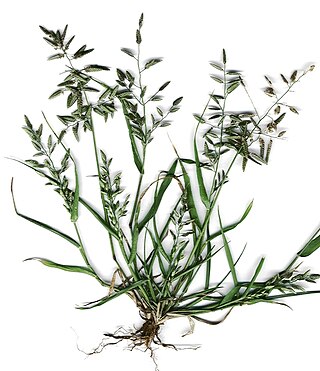
Eragrostis is a large and widespread genus of plants in the grass family, found in many countries on all inhabited continents and many islands.
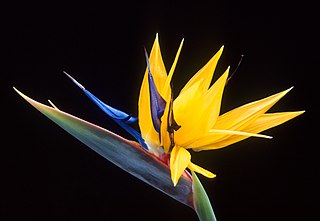
Strelitzia is a genus of five species of perennial plants, native to South Africa. It belongs to the plant family Strelitziaceae. A common name of the genus is bird of paradise flower/plant, because of a resemblance of its flowers to birds-of-paradise. In South Africa, it is commonly known as a crane flower.

Kirstenbosch is an important botanical garden nestled at the eastern foot of Table Mountain in Cape Town. The garden is one of 10 National Botanical Gardens covering five of South Africa's six different biomes and administered by the South African National Biodiversity Institute (SANBI). Prior to 1 September 2004, the institute was known as the National Botanical Institute.

Roridula is a genus of evergreen, insect-trapping shrubs, with two species, of about 1⅓–2 m. It is the only genus in the family Roridulaceae. It has thin, woody, shyly branching, upright, initially brown, later grey stems, with lance- to awl-shaped leaves crowded at their tips. The star-symmetrical flowers consist from the outside in of five, green or reddish, free sepals, alternating with five white, pink or purple, free petals. Further to the middle and opposite the sepals are five stamens with the anthers initially kinked down. These suddenly flip up if the nectar-containing swelling at its base is being touched. The center of the flower is occupied by a superior ovary. The leaves and sepals carry many sticky tentacles of different sizes, that trap insects. Roridula does not break down the insect proteins, but bugs of the genus Pameridea prey on the trapped insects. These later deposit their feces on the leaves, which take up nutrients from the droppings. The species can be found in the Western Cape province of South Africa. They are commonly known as dewstick or fly bush in English and vlieëbos or vlieëbossie in Afrikaans.
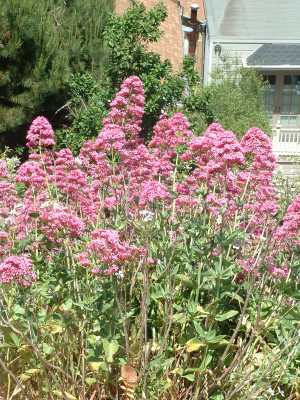
Centranthus ruber, the red valerian, spur valerian, kiss-me-quick, fox's brush, devil's beard or Jupiter's beard, is a popular garden plant grown for its ornamental flowers.

Lanaria is a monotypic genus of flowering plants containing a single species, Lanaria lanata, endemic to the southern coast of South Africa where it is associated with the fynbos belt. Lanaria lanata is commonly known as Cape edelweiss or lambtails. The genus is placed in the monotypic family Lanariaceae, a family only recently recognized by taxonomists. The APG IV system of 2016 does recognize this family.
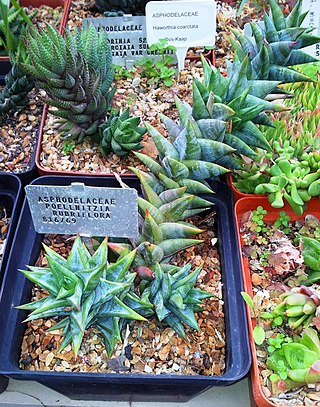
Astroloba rubriflora is a succulent plant found in the mountainous Karoo area around Robertson, South Africa. It is listed as a Vulnerable species on the IUCN global Red List.

Oscularia deltoides, the deltoid-leaved dewplant, dassievygie or sandsteenvygie is a species of flowering succulent plant in the fig-marigold family Aizoaceae that is native to the south-western Cape, South Africa.

The Harold Porter National Botanical Garden covers almost 200 ha between mountain and sea, in the heart of the Cape Fynbos region within the Kogelberg Biosphere Reserve to the east of Cape Town, South Africa, specifically near Betty's Bay along Clarence Drive (R44). With about 1,600 plant species, the area contains a floral diversity per unit area that is greater than anywhere else in the world. The Garden consists of 10 hectares of cultivated gardens and 190.5 hectares of pristine natural fynbos. In addition, 60 species of birds can be found there, as well as porcupines, genets, skunks, hyraxes, baboons, and snakes. Foot trails reach cliffs, ravines, heaths, forests, streams, and mountain pools.
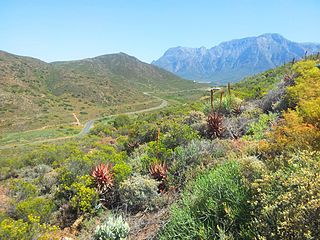
The Karoo Desert National Botanical Garden is a botanical garden focused on succulents and other plants of arid regions, that lies at the foot of the Hex River Mountains range, in the town of Worcester, South Africa.

The Hantam National Botanical Garden is situated outside Nieuwoudtville. It is the first National Botanical Garden in the Northern Cape. The main section of the garden is 5 km south-east of the town, neighbouring the Oorlogskloof Nature Reserve.
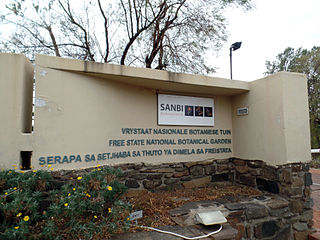
The Free State National Botanical Garden, located just outside Bloemfontein covers 70 hectares, and is home to about 400 species of plants, largely native to Free State and Northern Cape Provinces and Lesotho. Near Bain's Vlei, the garden was established in 1965, around 10 km north of downtown between picturesque dolerite rocks. 140 bird species, 50 mammal species, and 50 reptile species live in the park. A wild olive tree there is probably more than 200 years old. The herbarium preserves 50,000 species. There is also a bird hide, a dam, and wide lawns.

Oscularia is a genus of succulent flowering plants in the family Aizoaceae, native to semi-arid and rocky habitats in the Western Cape of South Africa.
The South African National Biodiversity Institute (SANBI) is an organisation tasked with research and dissemination of information on biodiversity, and legally mandated to contribute to the management of the country's biodiversity resources.
Graham Dugald Duncan(born 1959) is a South African botanist and specialist bulb horticulturalist at the Kirstenbosch National Botanical Garden, Cape Town, South Africa.

Protea aurea subsp. potbergensis, also known as the Potberg protea, or Potberg sugarbush, is a flowering plant of the genus Protea. It is endemic to South Africa and is found only in the Potberg near Cape Infanta. It grows to a height of 5 metres, and flowers primarily from May to June.
Didymaotus is a monotypic genus of flowering plant belonging to the family Aizoaceae, containing the single species Didymaotus lapidiformis. The plant is also known by the names stone plant and beeskloutjie. It occurs natively in the arid regions of Tanqua Karoo, near Ceres in the Western Cape. The generic name is taken from the Greek words didymos, meaning double, and aotus, meaning flower; the plant that bears two flowers. The specific epithet lapidiformis means stone-like, as it is not easily seen, blending in with its surroundings.

Loxostylis is a genus of flowering plants belonging to the family Anacardiaceae.
Athanasia pectinata is a species of plant from the Western Cape of South Africa.
















